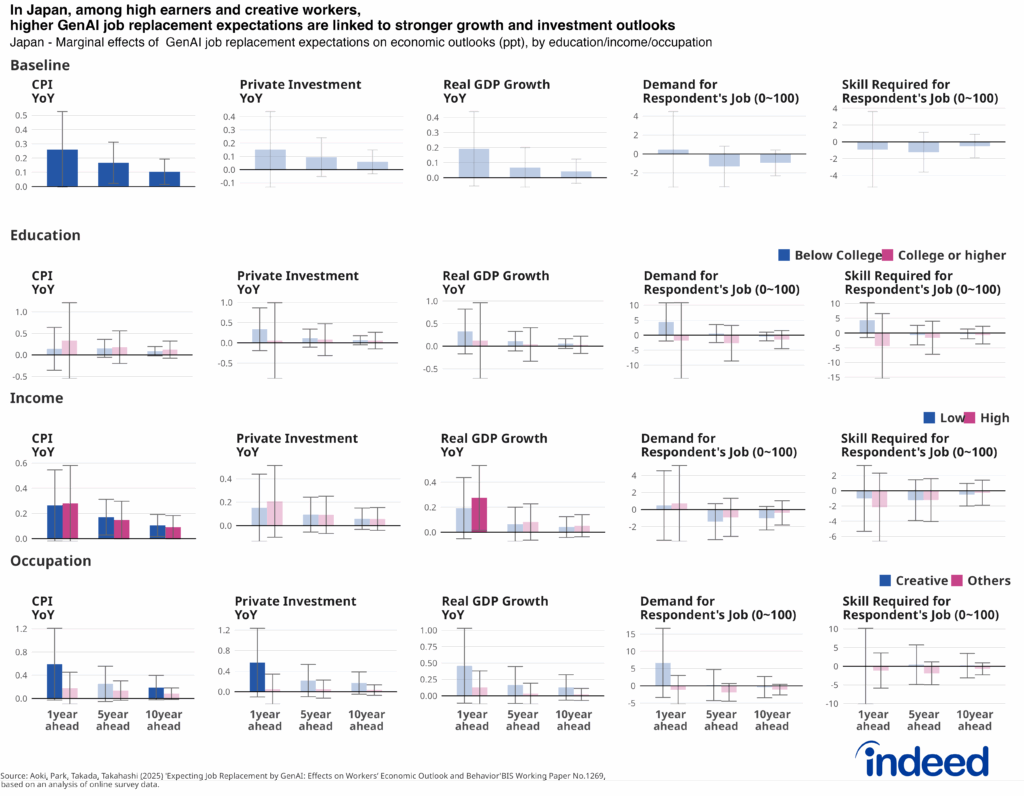Key points:
- Workers in Japan and the US each say they expect GenAI to replace 20–30% of jobs over the next 5–10 years.
- AI users in the US say they expect job replacement rates to be about 5 percentage points higher than non-users — a pattern not observed in Japan. Private use itself is also much more common in the US (69%) than in Japan (31%), suggesting that differences in exposure may shape beliefs.
- In Japan, heightened expectations about GenAI job replacement mildly increase inflation expectations, primarily through anticipated investment growth. These expectations also boost intentions to use GenAI at work.
Generative AI (GenAI) is rapidly transforming the global economy. But it’s not just what the technology can do that matters — it’s also what people believe it will do, and these expectations can significantly shape economic outcomes. If workers expect AI to boost productivity and create new opportunities, they may spend and invest more today, contributing to economic growth. However, if they fear GenAI will displace jobs or reduce the value of their skills, their economic behavior could shift to a more cautious direction.
To explore these dynamics, researchers from the Bank of Japan, Indeed Hiring Lab, the Bank of Korea, and Indeed Recruit Partners conducted large-scale online surveys and randomized experiments with full-time workers in Japan and the United States.
The results of these surveys highlight how worker expectations — shaped by public information — can channel the economic consequences of GenAI in divergent ways across countries and demographic groups.
What do workers expect from GenAI?
Workers in both countries shared strikingly similar expectations about how many jobs GenAI would replace in the near future. In both Japan and the United States, they predicted 10% of jobs would be replaced within a year, 20% within five years, and about 30% in Japan and 33% in the United States over the next 10 years.
| 1-yr expectation | 5-yr expectation | 10-yr expectation | |
| Japan | 10% | 20% | 30% |
| USA | 10% | 20% | 33% |
These expectations varied across demographic groups. In both Japan and the US, people with higher levels of education tended to anticipate lower levels of job replacement, though the pattern was more mixed in the US.
Additionally, US-based respondents who said they used GenAI in their personal lives reported higher expectations for job replacement than non-users, by about 5 percentage points at the median. This suggests that US GenAI users tend to view GenAI as a more disruptive force. In contrast, private GenAI users in Japan did not consistently report higher expectations. Moreover, private GenAI usage itself was far more common in the US (69%) than in Japan (31%), indicating that differences in exposure to and familiarity with the technology may shape how individuals perceive GenAI’s potential impact.
To test how information shaped beliefs, participants were split into two groups and given data based on expert estimates from prior studies. One was told GenAI is expected to replace 14% of current jobs, while the other was told it could replace 47%. Afterward, they were asked again about the future health of the labor market — including inflation and economic growth — to track how their outlook shifted.
Exposure to expert opinions was found to sway people’s views on GenAI’s potential labor market impact, with respondents in both the US and Japan revising their beliefs after receiving information about GenAI’s potential to replace jobs. The longer the forecast horizon, the more likely individuals were to update their beliefs, suggesting that as the uncertainty in personal responses increases, there is a greater tendency to rely on expert forecasts.
GenAI adoption intentions after changes in expectations: A surprising gap
While US and Japanese respondents mostly agreed in their initial expectations about GenAI’s potential to replace jobs, that trend did not continue. Japanese workers showed a notable increase in their willingness to use GenAI at work when shown data suggesting potentially higher job replacement risks. This may be because GenAI adoption is still low in Japan (only 31% report private use in this survey), leaving room for a “catch-up” effect.
By contrast, US workers, especially those with higher education, became more negative about future labor demand and skill needs, but showed no increase in interest in learning or using GenAI at work. This reflects the US’s higher private adoption rate (69%) and suggests skepticism, not enthusiasm, rises with perceived risk.
This gap in adoption is also confirmed by differences in shares of GenAI-related job postings between Japan and the US. As of April 2025, just 0.16% of all Japanese job postings mentioned any of a suite of GenAI-related keywords, compared to 0.26% of US job postings.
Do changes in beliefs about GenAI’s impact affect economic outlook?
How people revise their expectations about GenAI affects how they see the economy, but not always in the same way across countries or groups.
- In Japan, belief updates led to higher expectations for inflation and investment, especially among high-income and creative workers.
- For example, in creative fields, a 1-point increase in job replacement expectations led to a 0.57-point rise in investment expectations and a 0.59-point rise in inflation expectations.
- For example, in creative fields, a 1-point increase in job replacement expectations led to a 0.57-point rise in investment expectations and a 0.59-point rise in inflation expectations.
- In the US, average expectations for inflation or growth showed little change. However, college-educated respondents showed stronger reactions in other areas.
- College-educated respondents reacted most strongly: A 1-point increase in expected displacement led to an 8.3-point drop in labor demand expectations and a 9.1-point drop in skill requirements — a pattern consistent with other research, finding that highly educated workers are more sensitive to AI-related replacement risks.
- Investment expectations also diverged by education: Those with a college degree expected less investment, while others expected more — this divergence aligns with recent findings suggesting that GenAI can enhance the productivity of lower-skill workers by making tacit knowledge more accessible.

Conclusion
For employers and policymakers, these survey results highlight a few clear lessons. AI attitudes differ sharply across countries, so strategies for adoption and change management need to be tailored to local contexts.
In the US, highly educated workers may need extra reassurance that AI is meant to support, not replace, their roles. In Japan, where adoption is still relatively low, employers have an opportunity to close the gap by investing in training. And across markets, worker expectations about GenAI can serve as early signals — hinting at future behavior like reskilling, job changes or even investment choices.
Methodology
Details of this study are provided in:
In the BIS Working Paper, we examined various heterogeneities, including gender, age, income, and education. Here, we focus on three important dimensions: education, income, and whether the respondent is in a creative occupation.
In our online survey, creative occupations are defined as jobs involving one or more of the following domains: web and internet services; gaming and multimedia; advertising, graphic design, publishing, and printing; video, audio, events, entertainment, television, and broadcasting; and fashion, interior, spatial, and product design.
High-income respondents are defined as those earning over 10 million JPY annually in Japan, or over 100,000 USD annually in the United States.
Prior studies (e.g., Babina et al. (2023), Zhang & Dafoe (2020)) have shown that public attitudes toward AI vary by individual attributes. We then examined how macroeconomic expectations respond to belief changes across different groups.
Finally, we highlight the analytical importance of studying belief updating. People’s expectations and beliefs are not static; they evolve continuously in response to new information and knowledge. Understanding how expectations are updated helps us clarify how beliefs are initially formed and how they change over time.
Equally important, this approach helps address concerns about endogeneity in belief formation. For example, individuals who are naturally optimistic may simultaneously tend to overestimate GenAI’s potential for job displacement while also expressing stronger expectations for economic growth or investment. These simultaneous influences — driven by underlying personal traits — make it difficult to infer causality simply from correlations. To address this challenge, our study employs expert forecasts as an instrumental variable, leveraging the exogenous variation they provide to identify the causal impact of belief updates on macroeconomic expectations and GenAI-related behaviors.


